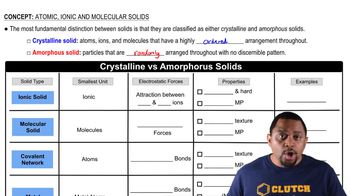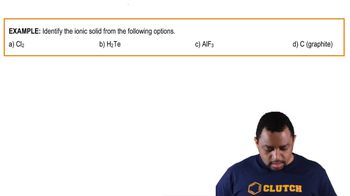Textbook Question
Barium has a density of 3.59 g/cm3 and crystallizes with the body-centered cubic unit cell. Calculate the radius of a barium atom.
 Verified step by step guidance
Verified step by step guidance



Barium has a density of 3.59 g/cm3 and crystallizes with the body-centered cubic unit cell. Calculate the radius of a barium atom.
Plonium crystallizes with a simple cubic structure. It has a density of 9.3 g/cm3, a radius of 167 pm, and a molar mass of 209 g/mol. Use these data to calculate Avogadro's number (the number of atoms in one mole).
Identify each solid as molecular, ionic, or atomic. a. CaCl2(s)
Identify each solid as molecular, ionic, or atomic. b. CO2(s)
Identify each solid as molecular, ionic, or atomic. d. I2(s)